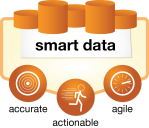Not all data is as valuable as others. The human resources to manually enter offline donor data can be daunting and so many times it is the last priority. There are great services that automate the collection of offline data at a reasonable cost. The first step in the automation process is to create a data value strategy. That will help justify the cost of capturing the offline donor data and integrating it into your donor systems.
The opportunity to collect offline data for most nonprofits is huge. We tend to underestimate how much of it we really have. For some retail oriented businesses it is close to 100 percent. Think about what you know about donors online and what you know about them offline.
Offline can include knowledge gained in the call center, by donation staff, from surveys, point of sale transactions and retail interactions from service personnel. It may be helpful to do a quick audit of all that you really have. If may be more than you think. And it may lead to great insight than online data which leads to action and engagement. It also getting easier and more cost effective to get the data via scanning / OCR technology.
Digital executives are passionate about getting insight on what is important to donors. Think about a world where you could act on the insights gained from your offline data. The cost of integrating may be worth its weight in gold.
The other side of this is that when donors give us information and tell us something, they expect us to remember it to provide them better service. The point of integrating offline data is to gain insight into donors that can’t be gained otherwise and to be able to act for better service.
Everyone can be involved in the effort. Imagine having a simple card that service personnel fill out with the answers to 3 questions what will give you great insight. They ask the questions and write down the answers. You have a service scan it and integrate it with your other donor data. What if you could get their email address? It may not be as difficult as you think. You can get everyone involved in the effort.
There is always the constraint of the budget. It is just too costly you think. Creating a value framework is not that difficult. A simple table can help you assess what offline data you have, what it would cost to get it into your systems and what insight it will give you to build relationships (leading to greater donation).
Alert!! Do you have a privacy policy? Is it up to date? How good is your data security? Has someone independent from your technical team assessed risks in your donor data security? Not having a budget to look at this is a high risk. The damage to your credibility is at stake.
Ask yourself:
- What is the value of the offline data you have about your donors? How much of it do you have? What would it cost to get it integrated with your other data?
- If you have that additional insight, what could you do with it to increase engagement, cross-sell, and up-sell?
- What don’t you know, that if you started asking and integrating the data, would be hugely valuable?
Here are the key ideas:
- Start by creating a strategy based on your offline data value framework.
- Begin by testing high insight data integration. Have a plan of what action you will take based on that insight.
- Encourage frontline staff to gather critical data that provides a high level of insight you can act on.
- Focus on insight and action.
- Create a team to oversee the effort and serve as ambassadors.
- Establish a budget to do something to get started.
- Pay attention to privacy and security.

